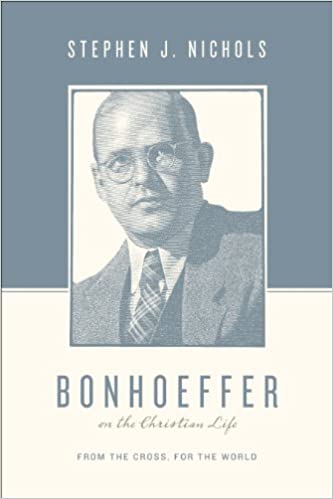CHAPTER 1
Meeting Bonhoeffer
To understand Bonhoeffer, we must understand, on the one hand, the limits of oneself and, on the other hand, the utter absence of limits of God. Bonhoeffer saw himself as limited in his understanding, limited in his experience, limited in his resolve, limited in his strength. To trust in himself would be purely—and merely—sanctimony, the religion of Pharisees. But to trust in God would be altogether different. To understand Bonhoeffer, we must first and foremost understand living by faith.
Dietrich Bonhoeffer once wrote that to live by faith (he would say to live truly) means “living unreservedly in life’s duties, problems, successes and failures, experiences and perplexities.” He wrote of the great cost of cheap grace to the church and its disciples in the modern world. He saw far too many examples of a culturally accommodated and culturally captive Christianity. He longed for a costly discipleship.
So he compelled the church and its disciples to consider costly grace, to consider the cost of discipleship. Costly discipleship is held captive to Christ; it is Christ-centered. He might have even coined a German word to express this, Christuswirklichkeit, a living in the one realm of the Christ reality.
Bonhoeffer also wrote persuasively of how this Christ-centered or Christ-reality living is the “life together,” the life of community, centered on our common union with Christ. No, we are not individual heroes achieving greatness—an unfortunate but prevalent model of living the Christian life in our day. Instead, we live together in Christ by faith.
Understanding Bonhoeffer, however, entails more than seeing this life of faith in Christ theologically. It also involves seeing how this theological center manifests itself in his life, in his daily comings and goings. Bonhoeffer was a theologian and a churchman, but he was also a person.
Bonhoeffer wrote poems, for example:
Distant or near,
in joy or in sorrow,
each in the other
sees his true helper
to brotherly freedom.
He tried his hand at a novel. He had a twin sister. He was, for a time, a youth pastor who could play the guitar. He frequented the theater, knew his way around an art gallery. He had opinions on art, music, and architecture. “You’re quite right,” he wrote from his prison cell, “about the rarity of landscape painting in the South generally. Is the south of France an exception—and Gauguin?” He was a professor of theology at the University of Berlin. He took on a rather rough band of youth on a different side of the tracks from which he had come of age. He prepared them for their first communion and, when the time had come for it, bought them all new suits for the occasion.
Bonhoeffer led an underground seminary, often looking out the window during his early afternoon lectures. On more than one day, with sun shining and a cool breeze gently bending tree limbs, he would grab a soccer ball on his way out the door and his students would fall in behind.
He was a spy. He helped Jews escape from the Nazis. He became part of a ring of conspirators in plots to assassinate Hitler.
He became engaged to Maria von Wedemeyer in January 1943, and three months later he was imprisoned at Tegel. During the fall months of 1944, he was transferred to the Gestapo prison in Berlin. He spent the final weeks of his life listening to sirens signaling the incessant dropping of bombs while cut off from his books, paper, pens, and ink.
He was a martyr.
Dietrich Bonhoeffer, both in his life and in his writings, draws us in. He demands our attention—not like the tantrums of a two-year-old, but like the quiet, trusted voice of a wise friend. That voice of Bonhoeffer’s, though quiet, has never been silent. A century after his birth, it resounds with clarity and grace. Historian and biographer David McCullough has said, “We are shaped by those we never met.” That’s quite true—or at least it should be.
Perhaps Bonhoeffer shapes us best by showing us in word and in deed, as a theologian and in his life, how to live the Christian life, how to be a disciple of Christ, how to live in the Christuswirklichkeit. His book The Cost of Discipleship gets all of the attention on this score, and rightfully so. The Cost of Discipleship would be a legacy in and of itself. But Bonhoeffer offers us more. We owe it to ourselves, as well as to the honor of his memory, to widen our attention.
From The Cost of Discipleship we learn of the difference between a Christianity that asks nothing of us and one that requires a 180-degree turn from all that comes naturally. We learn of the difference between cheap grace and costly grace.
From Life Together and from his doctoral thesis, Sanctorum Communio (The Communion of Saints), written as he was not yet twenty-one, we learn that the Christian life is lived both alone and together. It is the together part that can be a challenge for us. It is also the together part that has become in our day the buzzword of community.
For Bonhoeffer, community was more than a trendy word; it was his life. In Letters and Papers from Prison, edited by Eberhard Bethge and published posthumously, Bonhoeffer teaches us that “it is only by living completely in this world that one learns to have faith,” words he wrote while living in a six-by-nine-foot prison cell. We also learn from his unfinished and unpublished novel, written during his imprisonment, about the true nature and task and mission of the church. Academic books, like his unfinished magnum opus Ethics, as well as his numerous essays, lectures, sermons, and even his diaries and scribbled-down rough thoughts from his imprisonment, round out what Bonhoeffer has to offer us in words.
As for what Bonhoeffer offers us in deeds, both in his life and in his death he shows us how to love and serve God. Like Paul, Bonhoeffer knew firsthand both extremes of plenty and of want (Philippians 4:12). Growing up he enjoyed the life of moderate wealth. Childhood was punctuated with long vacations at the summer home, governesses, and family oratorios performed in their very own conservatory, which doubled as the family parlor. He started his academic career at the prestigious University of Berlin.
But along came Hitler. Bonhoeffer lost his license to teach, and he traded in Berlin for Finkenwalde. Yes, Finkenwalde was an estate, but better to think run-down monastery than paneled walls and luxurious rooms. And then he was sent to prison. While in prison he once wrote of his longing to hear birds and see color. He knew all too well what it meant to be in want.
Or am I only what I know of myself,
restless and longing and sick, like a bird in a cage.
struggling for breath, as though hands were compressing my throat.
Yearning for colors, for flowers, for the voices of birds,
thirsting for words of kindness, for neighborliness.
And, like Paul, these experiences of plenty and want led Bonhoeffer to contentment. He expressed this in a poem marking the occasion of the New Year in 1945. Bonhoeffer had spent the whole of 1944 in Nazi prisons. “The old year,” he writes of 1944, “still torments our hearts.” By December he was in Berlin, and his precious flow of letters and books in and out had been cut to a mere trickle.
In one of those rare letters, allowed to be sent to his mother on her birthday, he tucked in his New Year’s poem entitled “The Powers of Good.”
Should it be ours to drain the cup of grieving
even to the dregs of pain,
at thy command, we will not falter, thankfully receiving
all that is given by thy loving hand.But should it be thy will once more to release us
to life’s enjoyment and its good sunshine,
that which we’ve learned from sorrow shall increase us,
and all our life be dedicated as thine.
It was Christ who gave us the ultimate paradox of life: in the keeping of our life we lose it, but in the giving of our life we find it (Matthew 10:39). Christ spoke these words immediately on the heels of telling his disciples to take up their cross (Matthew 10:38). From the very beginning that has been the call to discipleship, the call to live the Christian life. Bonhoeffer, as well as or if not better than any other person in the twentieth century, understood this and lived it, both in darkest night and in the full light of the sun. He understood what it meant to be unreservedly dedicated to Christ, to live by faith.
Consequently, Bonhoeffer deserves a place among theologians of the past who can serve as guides for us in the present for living the Christian life. He literally wrote the book on discipleship, but he also, as mentioned above, has more to offer than his classic text The Cost of Discipleship. He lived discipleship. An old Carter family song croons, “It takes a worried man to sing a worried song.” I think that means authenticity matters. And the stakes regarding authenticity could not be higher than when it comes to discipleship. This lyric from the Carter song also means you can spot a fake. And Bonhoeffer was no imposter. He was a disciple, so he could well sing—and preach and write—of discipleship.
While Bonhoeffer does speak of the personal spiritual disciplines, the “life alone” as he calls it, he also speaks of the “life together,” reminding us of our union with Christ and the common union we share with one another in the body of Christ, the church. While Bonhoeffer does speak of duty, he also heralds grace. He is, after all, a Lutheran, so he knows a thing or two about grace. Finally, while Bonhoeffer does speak of the life to come, his is a “worldly discipleship,” deeply connected to the ups and downs of life in this fallen world. This voice from the past can help us avoid missteps on our walk with Christ in the present. We owe it to ourselves to meet him and to listen to what he has to say—both in word and in deed.






